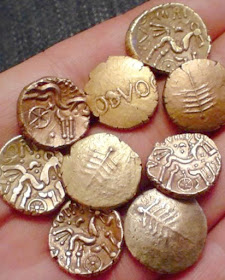 |
A pair of Anglo-Saxon saucer brooches found in topsoil that
had been removed from an archaeological site prior to
recording and spread on a local farmer's field.
photo: Dean Crawford
|
"About twenty five years ago, archaeological excavations were carried out behind the Anglo-Saxon public house in Bidford. The archaeologists were asked by my colleague, Jim, if he could assist, if only by scanning the discarded topsoil. The answer was a defiant NO. What a wasted opportunity.
"If the archaeologists had as much knowledge of the area as Jim, they would have known that the site in question was disturbed in the nineteenth century, so a great deal of what they would had been looking for would already be unstratified and possibly nearer the surface. Yet, a deep layer of topsoil was stripped and discarded.
"By a strange coincidence, this topsoil was immediately shipped out in large trucks and dumped onto the nearby farm, where Jim actually had permission from the landowner. So he did get to scan the spoil after all.
"What he found was quite amazing; many late Roman and Anglo-Saxon finds. One has to wonder how this would have confused any future investigation on this nearby land. Or would it? perhaps the archaeologists would discard the topsoil for a second time, and dump it on a third farm? and continue on like this.
"A disturbed context, or not, there was so much knowledge and information lost by the archaeologists using this method. Yet Jim scanned the discarded soil, recorded all the Roman coins, Roman brooches, Anglo-Saxon Sceats and important brooches. The last time I spoke to Jim, he had recorded at least sixty early Anglo-Saxon coins, including many new varieties according to the Fitzwilliam Museum at Cambridge. [these would have been recorded in the Department of Coins and Medals' Corpus of Early Medieval Coin Finds]
"I only posses one photograph from back then: two large Anglo-Saxon saucer brooches that he found in the soils that were transferred from the excavation site, which would have certainly been from a grave.
John's Coydog Community page



































